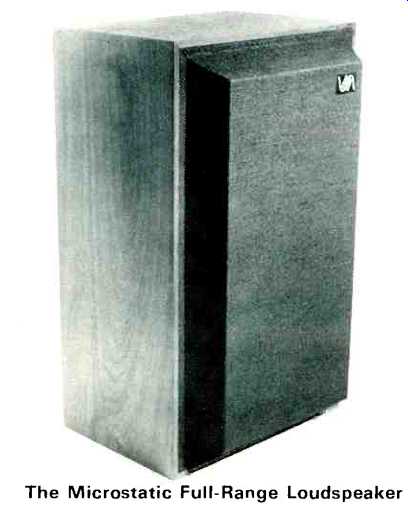
Manufacturer's Specifications:
Bass unit: 10 inch.
Treble: Five cone types in a multiple array.
Crossover: Mechanical, 1700 Hz.
Enclosure: Air suspension.
Cabinet: Walnut vinyl.
Grille: Black cloth, functional or decorative styles.
Dimensions: 25 1/2 by 15 by 12 1/2 inches deep.
Price: $149.50.
The first ads for the Microstatic speaker system showed a bunch of five tweeters and a bass unit all bulging out of the grille cloth-looking rather ugly. The caption read "If this design is right, then all the others must be wrong." Since then, Microstatic have had second thoughts and they now offer another design where the speakers are modestly hidden by an extended grille cloth. But the basic concept is unchanged and the treble units are still mounted outside the baffle in a cross formation-a semi-decahedron array according to the leaflet. The original model is still available for those who believe the functional design is more aesthetically satisfying. Two of the tweeters have 1 3/4 inch cones and three are 1 1/4 inch. All have closed backs and the object of the configuration is to give a wide dispersion. Two level controls are provided, one adjusting on-axis response and the other controlling the input to the angled units.
The bass unit has a four-layer 1 1/2 inch voice coil and the response rolls off smoothly enough to avoid using a crossover series inductor. Crossover point is about 1700 Hz. The enclosure is sealed and system resonance is commendably low at 49 Hz.
Measurements

Fig. 1--Frequency response measured with one-third octave
pink noise. Fig. 2--Low frequency distortion and some SPL
figures.
Figure 1 shows the response measured with one-third octave pink noise. B was taken on axis with A and C taken with the HF level control at minimum and maximum. The lower curve was measured with both controls in the normal position. D was taken on-axis, E at 30 degrees and F at 60 degrees. Figure 2 shows the THD at low frequencies with some SPL measurements and Figure 3 gives the impedance characteristics. Lowest point was just under 7 ohms, rising to nearly 20 ohms at 2 kHz. Tone-burst responses at 100, 500 and 5 kHz are shown in Figure 4. The system could handle 81 watts continuous power at 40 Hz without distress and 152 watts at 100 Hz. White noise tests showed very low coloration.

Fig. 3--Impedance characteristics. Fig.
4--Tone-burst responses. A was taken at 100 Hz, B at
500 Hz and C at 5 kHz.
Listening Tests
Sensitivity of the Microstatic was slightly above average and so we used a Marantz 2010 for some of the tests. This is an inexpensive receiver rated at some 12 watts per channel and having a better than average FM section. It was quite adequate for a medium-size room, but we changed over to a Citation 12 amplifier combination with Citation 15 tuner in a much larger room. Best position for the speaker was away from the room corners, about 18 inches up from the floor.
Bass was solid and well-defined and high frequency dispersion was excellent. We preferred both controls at maximum positions and with the systems angled slightly inwards, the stereo image was excellent with no sign of 20 foot violins and "Jolly Green Giant" voices. At $149.50, the Microstatics are excellent value for the money. Indeed, they compare very favorably with a pair of $250. systems we used for comparison.
-T.A., G. W.T.
(adapted from Audio magazine, Jun. 1973)
Also see:
Microstatic MS-1 Add-On Speaker (Jul. 1973)
Rogersound RSL 28 Loudspeaker System (Jun. 1973)
Dynaco A-35 Loudspeaker System (Jun. 1973)
Dynaco A-25XL Loudspeaker (Equip. Profile, Nov. 1976)
= = = =